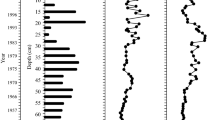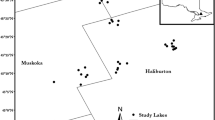Abstract
A paleolimnological evaluation of cladoceran microfossils was initiated to study limnological changes in Lake Apopka, a large (125 km2), shallow (mean depth = 1.6 m), warm, polymictic lake in central Florida. The lake switched from macrophyte to algal dominance in the late 1940s, creating a Sediment Discontinuity Layer (SDL) that can be visually used to separate sediments derived from macrophytes and phytoplankton. Cladoceran microfossils were enumerated as a means of corroborating extant eutrophication data from the sediment record. Inferences about the timing and trajectory of eutrophication were made using the cladoceran-based paleo-reconstruction. The cladoceran community of Lake Apopka began to change abruptly in both total abundance and relative percent abundance just before the lake shifted from macrophyte to algal dominance. Alona affinis, a mud-vegetation associated cladoceran, disappeared before the SDL was formed. Planktonic and benthic species also began to increase below the SDL, indicating an increase in production of both planktonic and benthic species. Chydorus cf. sphaericus, an indicator of nutrient loading, increased relative to all other cladocerans beginning in the layer below the SDL and continuing upcore. Changes in the transitional sediment layer formed before the lake switched to phytoplankton dominance, including an increase in total phosphorus concentration, suggest a more gradual eutrophication process than previously reported. Data from this study supported conclusions from other paleolimnological studies that suggested anthropogenic phosphorus loading was the key factor in the hypereutrophication of Lake Apopka.
Similar content being viewed by others
References
Appleby, P. G. & F. Oldfield, 1983. The assessment of 210Pb data from sites with varying sediment accumulation rates. Hydrobiologia 103: 29–35.
Bachmann, R. W., M. V. Hoyer & D. E. Canfield Jr., 1999. The restoration of Lake Apopka in relation to alternative stable states. Hydrobiologia 394: 219–232.
Battoe, L. E., M. F. Coveney, E. F. Lowe & D. L. Stites, 1999. The role of phosphorus reduction and export in the restoration of Lake Apopka, Florida. In Reddy, K. R., G. A. O'Connor & C. L. Schelske (eds.), Phosphorus Biogeochemistry in Subtropical Ecosystems. Lewis Publishers, Boca Raton, 511–526.
Brezonik, P. L., C. D. Pollman, T. L. Crisman, J. N. Allinson & J. L. Fox, 1977. Limnological studies on Lake Apopka and the Oklawaha chain of lakes 1. Water Quality in 1977. Report to Florida Department of Environmental Regulation, Tallahassee. Report No. ENV–07–78–01, Department of Environmental Engineering Sciences, University of Florida, 283 pp.
Brezonik, P. L., T. L. Crisman, C. D. Pollman & P. D. Sacco, 1980. Limnological studies on Lake Apopka and the Oklawaha chain of lakes. 3. Water quality in 1979. Report No. ENV–07–80–02, Department of Environmental Engineering Sciences, University of Florida, 109 pp.
Brezonik, P. A., S. D. Preston & T. L. Crisman, 1981. Limnological studies on Lake Apopka and the Oklawaha chain of lakes. 4. Water quality in 1980 and a summary of the four-year database. Report No. ENV–07–81–02. Department of Environmental Engineering Sciences, University of Florida, 140 pp.
Chengalath, R., 1982. A faunistic and ecological survey of the littoral Cladocera of Canada. Can. J. Zool. 60: 2668–2682.
Crisman, T. L., 1980. Chydorid cladoceran assemblages from subtropical Florida. In Kerfoot, W. C. (ed.), Evolution and Ecology of Zooplankton Communities Special Symposium Volume 3. University Press of New England. Hanover, New Hampshire, 657–668.
Crisman, T. L., 1978. Interpretations of past environments from lacustrine animal remains. In Walter, D. (ed.), Biology and Quaternary Environments. Australian Academy of Sciences, Canberra, 69–101.
Crisman, T. L., J. R. Beaver, J. K. Jones, A. E. Keller, A. G. Neugaard & V. Nilakantan, 1992. Historical Assessment of Cultural Eutrophication in Lake Weir, Florida. Department of Environmental Engineering Sciences, University of Florida, Gainesville and St. John's River Water Management District, Palatka, FL, 442 pp.
Fisher, M. M., M. Brenner & K. R. Reddy, 1992. A simple, inexpensive piston corer for collecting undisturbed sediment/ water interface profiles. J. Paleolim. 7: 157–161.
Frey, D. G., 1980. On the plurality of Chydorus sphaericus (O. F. Müller) (Cladocera, Chydoridae), and designation of a neotype from Sjaelsø, Denmark. Hydrobiologia 69: 83–123.
Frey, D. G., 1986. Cladocera Analysis. In Berglund, B. E. (ed.), Handbook of Holocene Palaeoecology and Palaeohydrology. John Wiley & Sons Ltd., 667–692.
Kenney, W. F. III, 1997. A comparison of chemical assays for the estimation of bioavailable phosphorous in Lake Apopka sediments. M. S. Thesis, University of Florida, 67 pp.
Lowe, E. F., L. E. Battoe, M. F. Coveney & D. L. Stites, 1999. Setting water quality goals for restoration of Lake Apopka: Inferring past conditions. Lake Reserv. Manage. 15: 103–120.
Osborne, J. A., 1974. Unpublished zooplankton data for Lake Apopka, Florida. Florida Technological University, Orlando, FL.
Reddy, K. R. & D. A. Graetz, 1991. Internal nutrient budget for Lake Apopka. Final Report, Project No. 15–150–1 SWIM 1987–90.
Special Publication SJ 91-SP6. St. Johns River Water Management District, Palatka, FL, 371 pp.
Schelske, C. L., 1997. Sediment and phosphorus deposition in Lake Apopka. Final Report, Contract No. 96W213. Special Publication SJ97-SP21. St. Johns River Water Management District, Palatka, FL, 97 pp.
Schelske, C. L., 2000. Wind or nutrients: Historic development of hypereutrophy in Lake Apopka, Florida. Arch. Hydrobiol. Spec. Issues Advanc. Limnol. 55: 543–563.
Schelske, C. L., C. M. Donar & E. F. Stoermer, 1999. A test of paleolimnological proxies for the planktonic/benthic ratio of microfossil diatoms in Lake Apopka. In Mayama, S., M. Idei & I. Koizumi (eds.), 14th Diatom Symposium. Koeltz Scientific Books, Koenigstein, 367–382.
Tuschall, J. R., T. L. Crisman, P. L. Brezonik & J. N. Allinson, 1979. Limnological Studies on Lake Apopka and the Oklawaha Chain of Lakes 2. Water Quality in 1978. Report to Florida Department of Environmental Regulation, Tallahassee. Report No. ENV–07–79–02, Department of Environmental Engineering Sciences, University of Florida, 114 pp.
Waters, M. N., 2000. The use of sedimentary algal pigments to infer historic algal communities in Lake Apopka, Florida. M. S. Thesis, University of Florida, 56 pp.
Author information
Authors and Affiliations
Rights and permissions
About this article
Cite this article
Shumate, B.C., Schelske, C.L., Crisman, T.L. et al. Response of the cladoceran community to trophic state change in Lake Apopka, Florida. Journal of Paleolimnology 27, 71–77 (2002). https://doi.org/10.1023/A:1013599502262
Issue Date:
DOI: https://doi.org/10.1023/A:1013599502262




